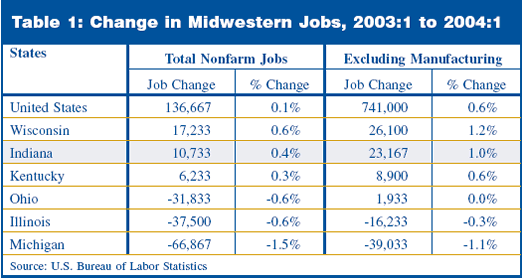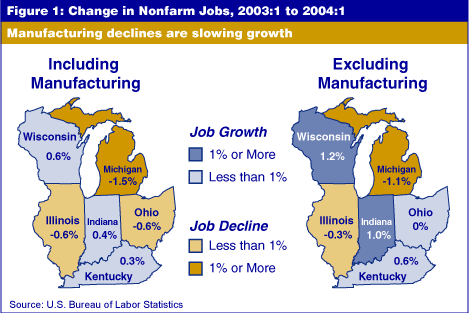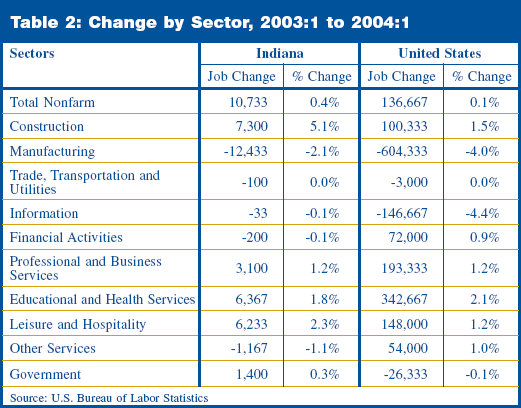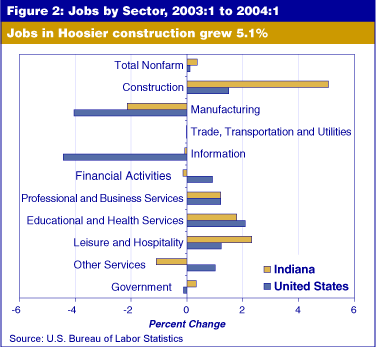Job Gains and Losses by Sector: The First Three Months of 2003 and 2004 Compared
Historically, Indiana (led by manufacturing) has gone into recessions ahead of the nation. Conversely, Indiana has often been among the leaders in job growth at the beginning of recovery periods, again led by manufacturing. While many economists predicted the Indiana recovery would once more be led by manufacturing, manufacturing is still declining (as of the first three months of 2004) and appears to be acting as a drag on the recovery across the nation, particularly in the Midwest (see Table 1 and Figure 1).

Indiana gained an estimated 10,000 jobs in the first quarter of 2004, using seasonally adjusted data. Excluding manufacturing, however, Indiana gained over 23,000 jobs. This effect is more notable in other states: Excluding manufacturing, Ohio goes from a job loss of 32,000 jobs to a gain of almost 2,000.

What should be considered is that recessions are more than business closings and job loss. Recessions often herald major economic restructuring. Continued manufacturing automation, outsourcing, in-sourcing, imports and capital investment relationships may have so altered the economic structure of Hoosier manufacturing that, while a strong recovery may still occur, it may not be as strong as in previous recoveries.
Therefore, if manufacturing is not leading the way, how is Indiana outpacing the nation in job growth, based on the first few months of 2004? Although the number of manufacturing jobs continues to drop, Indiana’s rate of decline is almost half that of the United States (see Table 2). It must be noted that manufacturing jobs were declining nationally before the recession and a Robert Reich article suggested manufacturing job decline is a global issue.

The construction sector in Indiana currently shows the greatest job growth, outperforming the nation with a growth rate more than three times that for the United States (see Figure 2). Since we are using seasonally adjusted data, this increase should not be influenced by seasonal or other time-related factors. Unless this increase is a short-term phenomenon or a data aberration, this is the best indictor that the Indiana economy is rebounding. Construction often precedes growth in other sectors. This sector should be watched closely to determine the strength of its growth and if it is sustained over time.

Hoosiers may be feeling better about their economic condition as job growth in the leisure and hospitality sector is growing almost twice as fast as the nation. Government jobs are also up slightly while the United States declines. (Before claims of increased bureaucracy are made, remember most employment in this sector comes from public education and public health services, such as city and county hospitals.)
The change in Indiana jobs in trade, transportation and utilities, professional and business services and educational and health services roughly parallels the nation.
Indiana shows a slight decrease in information jobs, compared to a much greater national downturn. Within the information sector, a sharp downturn in telecommunications, followed by declines in the Internet service providers, search portals and data processing subsector and the Internet publishing and broadcasting subsector, suggests continued fallout from the burst in the IT bubble.
Financial activities and other services are the only sectors showing job decline in Indiana as opposed to national job growth. Detailed information to explain this is not available, but the financial activities sector has been a weak performer in Indiana for many years.
Ted Jockel
Senior Economist, Indiana Department of Commerce
